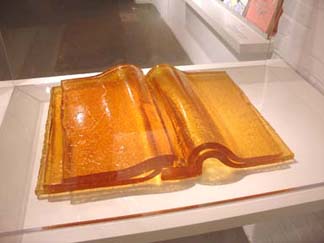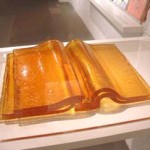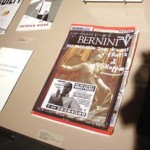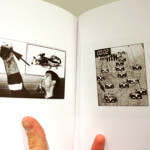Space Other’s current exhibit Artists’ Books: Transgression/Excess brings together more than 150 artists who have worked with the artist book over the course of the 20th and 21st centuries. The exhibition features more than 200 pieces and feels more like a library or bookstore than an art exhibit. Gallery visitors can peruse and handle any of the books in the exhibit. The installation allows for leisurely browsing, as the gallery has installed desks and a reading room for viewers to spend significant time with the artworks. One can spend months going through this substantial, yet temporary, collection of artist book production. The arrangement and grouping of books within vitrines, on bookshelves, and on the gallery walls does not follow a chronological order, nor did the curators choose to group books together by media, geographic local, or style. Books are juxtaposed and aligned in a way that is more random and associative.
As I was opening books and browsing I was struck by the prevalence of books that, due to their physicality, made reading very difficult. Throughout the exhibit one comes across books that border on the sculptural, defying the boundaries of the traditional page in order to explore the possible relationships between materiality and text. With many of the artists’ books on display, the objecthood of the book itself is a crucial aspect to be experienced and interpreted. Unlike traditional books, where cover and page act as a delivery system for the author’s text-based narrative, a lot of the work in AB:T/E foregrounds or renders theatrical the act of reading itself, making the reader/viewer conscious of their active role in the process of interpretation.
Michael Dorner’s Gelatine-Book, 2007, is exactly what the title describes. It is enclosed within a vitrine. Weighty and huge, yet ready to fall apart at the slightest attempt to turn a page, Dorner’s book focuses us on the fragility of all books, their subjection to wear and tear and eventual disposal. The cover of Guy Debord’s and Asger Jorn’s 1959 Situationist publication Mémoires is lined on the front and back with rough sandpaper. Not only does this make reading the book slightly uncomfortable, but to try to squeeze Mémoires between other publications on a bookshelf would certainly result in difficulty and some scratched bookcovers. When placed near other books, Mémoires is, in its physicality, abrasive and potentially destructive. In Joep van Liefland’s VP-Glossy #3 das Magazin zur Kunst, Erotic, and Shopping, 2005, pornography, department store circulars, and reproductions of famous artwork are stapled and collaged together from a variety of sources into a sophomoric, haphazard “glossy.” VP-Glossy #3 utilizes the ubiquitous and degraded material of newspaper ads and magazine pages to give form to the complex and twisted relationships between consumerism, sex, and art.
Other books in the show re-imagine the “book” as a kind of collection, archive, or portfolio of sorts. Andrew Mobray’s Palingenisis is a personal archive of collected objects, photographs, newspaper cutouts, assorted found objects and ephemera which are sometimes loosely collaged together onto board and placed into a hand-made box. Within Palingenisis one finds sketches and photographs of the artist’s completed artworks, sketches, personal musings and other ideas. The viewer is made to wrestle with the awkwardness of the collaged pages and their clumsy placement within the box. Palingenesis is not so much a book as it is a kind of vessel where past artworks and ideas can be given new life through association and a direct engagement with the viewer.
Peter Pillers’ Archive, Band 9 (published in 2006), is a collection of newspaper photographs which feature the ubiquitous pointing arrow graphic used to draw a viewer’s attention to a certain element in the picture. In one photo an arrow points toward the substance in a glass held by a firefighter, in another photo toward the second place car in a motor race with only two seconds left. Wretched from their original context in the newspaper, Pillers’ photographs float free of any meaning they previously held. The arrow graphic, which previously clarified and informed, now becomes an empty signifier of sorts, its purpose and placement a puzzle. Pillers’ collection of images not only describes the dependence of documentary or news photographs to their context but it also provides a new context for them via a typology of the pointing arrow.
I appreciate the curators’ choice to avoid an art historical survey in favor of creating a situation where one can browse, hang out, relax, and enjoy a good book. In the spirit of the artist book, which breaks down barriers between various media, AB:T/E breaks down the barriers between artwork and viewer by making the work available to be handled. The inclusiveness of the curation and the accessibility of the work makes Artists’ Books: Transgression/Excess a show that would reward multiple visits.
Links:
Space Other
Artists’ Books: Transgression/Excess is on view until March 31st at Space other located at 63 Wareham Street, Boston, MA
All images are courtesy of the artists, the author, and Space Other.







